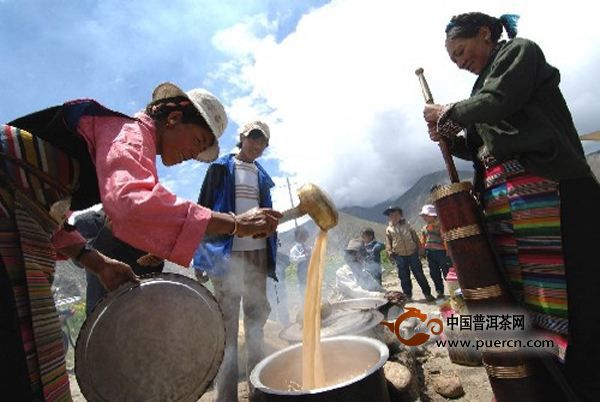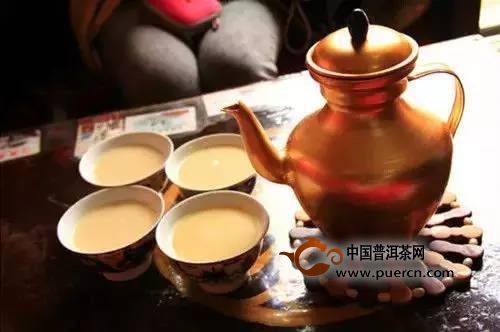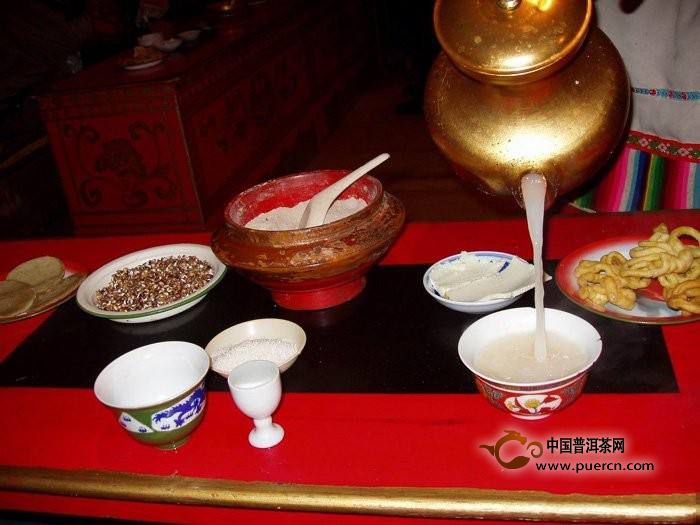Tibet is known as the “roof of the world”. The terrain is high, the air is thin, the climate is dry and cold. Most of the local people believe in Lamaism. They mainly graze and plant dryland crops. There are few vegetables and fruits, and they mainly eat milk and meat. Tea is the main source of nutritional supplement for local people and has become an indispensable food for life. At present, Tibet's annual per capita tea consumption is about 15 kg, which is the highest in the China.

Tibetans drink pure tea, milk tea, and butter tea. But the most popular is butter tea. Butter tea is a kind of tea which is made by adding special ingredients such as ghee to the tea soup and then processing it by special methods. The so-called ghee is to boil milk or goat milk, stir with a spoon, pour into a bamboo bucket, and then condense a layer of fat on the surface of the solution after cooling. As for tea, it is generally used compressed puerh tea. The processing method of butter tea is more complicated. Generally, the water is boiled in a pot. After the water is boiled, the tea is crushed with a knife and cooked in boiling water for about half an hour. After the tea juice is leached, the tea leaves are filtered. Put the tea juice in a long cylindrical tea bucket. At the same time, boil the milk in another pot and cook until the surface is condensed with a layer of ghee. Pour it into the tea pot containing the tea soup and put the right amount of salt and sugar.

The tea pot used for butter tea is mostly made of copper and even made of silver. The tea set for savory tea is mostly silver, and even processed with gold. Although the tea bowl is made of wooden bowls, it is often inlaid with gold, silver or copper.

When the butter tea started, it could not be verified. Legend has it that its earliest appearance was when the Wencheng of the Tang Dynasty brought tea to Tibet, and after repeated iterations, it gradually formed this kind of butter tea. So nowadays, as long as there are guests coming from afar, Tibetan compatriots often talk about this story to commemorate Wencheng.

Tibetans drink pure tea, milk tea, and butter tea. But the most popular is butter tea. Butter tea is a kind of tea which is made by adding special ingredients such as ghee to the tea soup and then processing it by special methods. The so-called ghee is to boil milk or goat milk, stir with a spoon, pour into a bamboo bucket, and then condense a layer of fat on the surface of the solution after cooling. As for tea, it is generally used compressed puerh tea. The processing method of butter tea is more complicated. Generally, the water is boiled in a pot. After the water is boiled, the tea is crushed with a knife and cooked in boiling water for about half an hour. After the tea juice is leached, the tea leaves are filtered. Put the tea juice in a long cylindrical tea bucket. At the same time, boil the milk in another pot and cook until the surface is condensed with a layer of ghee. Pour it into the tea pot containing the tea soup and put the right amount of salt and sugar.

The tea pot used for butter tea is mostly made of copper and even made of silver. The tea set for savory tea is mostly silver, and even processed with gold. Although the tea bowl is made of wooden bowls, it is often inlaid with gold, silver or copper.

When the butter tea started, it could not be verified. Legend has it that its earliest appearance was when the Wencheng of the Tang Dynasty brought tea to Tibet, and after repeated iterations, it gradually formed this kind of butter tea. So nowadays, as long as there are guests coming from afar, Tibetan compatriots often talk about this story to commemorate Wencheng.